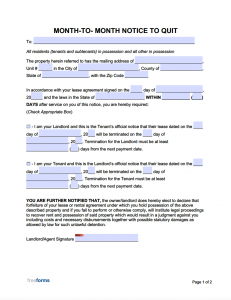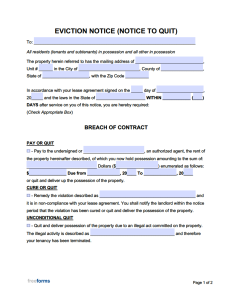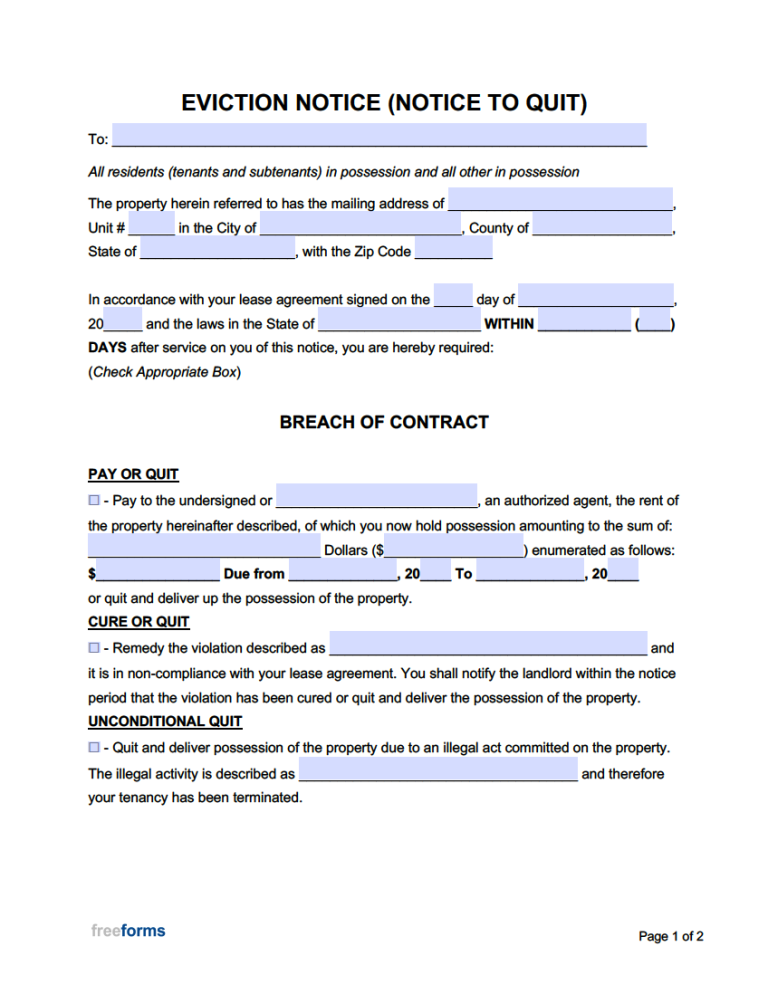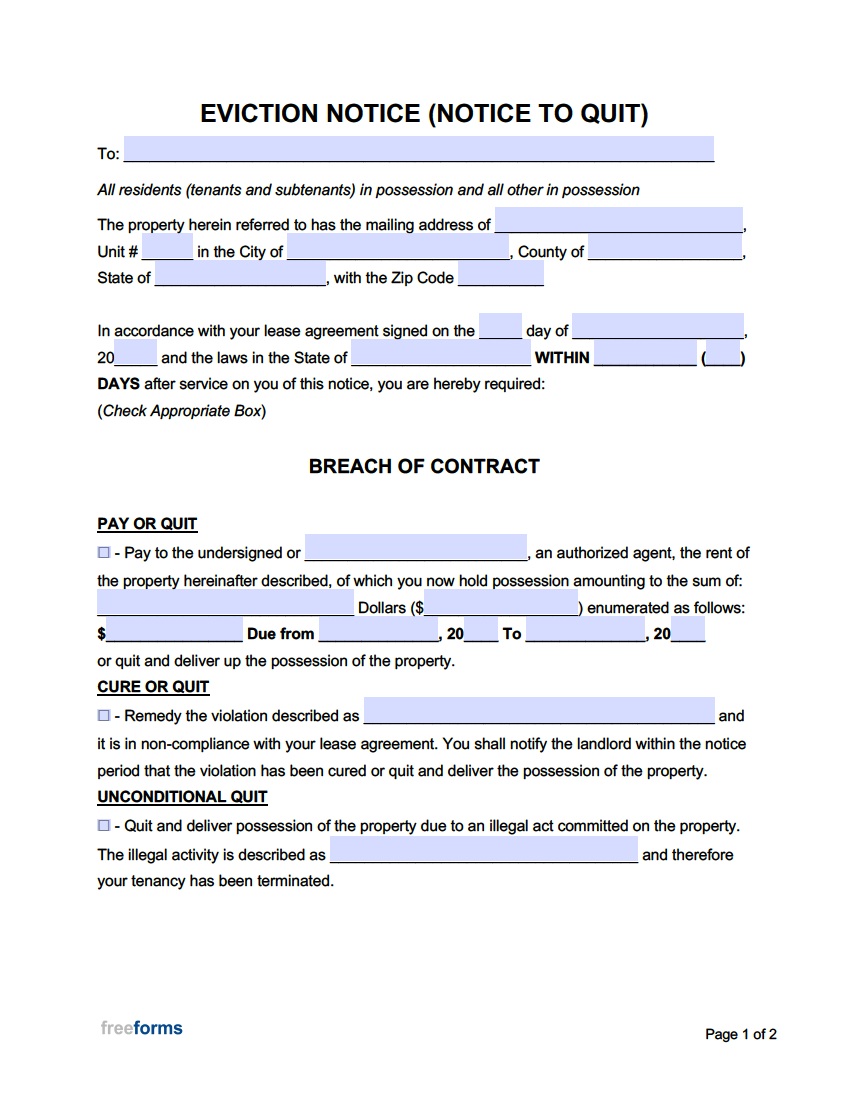By State
- Alabama
- Alaska
- Arizona
- Arkansas
- California
- Colorado
- Connecticut
- Delaware
- Florida
- Georgia
- Hawaii
- Idaho
- Illinois
- Indiana
- Iowa
- Kansas
- Kentucky
- Louisiana
- Maine
- Maryland
- Massachusetts
- Michigan
- Minnesota
- Mississippi
- Missouri
- Montana
- Nebraska
- Nevada
- New Hampshire
- New Jersey
- New Mexico
- New York
- North Carolina
- North Dakota
- Ohio
- Oklahoma
- Oregon
- Pennsylvania
- Rhode Island
- South Carolina
- South Dakota
- Tennessee
- Texas
- Utah
- Vermont
- Virginia
- Washington
- West Virginia
- Wisconsin
- Wyoming
By Type
 Month-to-Month Notice to Quit – Tenants and landlords looking to terminate a monthly rental contract may use this form to notify the other of their decision to end the tenancy.
Month-to-Month Notice to Quit – Tenants and landlords looking to terminate a monthly rental contract may use this form to notify the other of their decision to end the tenancy.
Download: Adobe PDF, MS Word (.docx)
Notice to Pay or Quit (for Late Rent) – Sent to a tenant who is behind on rent and must either pay the outstanding amount or vacate within a specific period.
– Sent to a tenant who is behind on rent and must either pay the outstanding amount or vacate within a specific period.
Download: Adobe PDF, MS Word (.docx)
Notice to Cure or Quit (for Non-Compliance) – A formal letter a landlord issues to inform a tenant that they have violated the lease agreement, not relating to a late or partial rent payment.
– A formal letter a landlord issues to inform a tenant that they have violated the lease agreement, not relating to a late or partial rent payment.
Notice to Quit (for Illegal Activity) – A legal document a landlord delivers to initiate the eviction process for tenants who commit or allow illegal acts on the premises.
– A legal document a landlord delivers to initiate the eviction process for tenants who commit or allow illegal acts on the premises.
What is an Eviction?
An eviction is a legal process where a landlord removes a tenant from a rental property due to a lease violation. A landlord must follow the legal process and have a valid reason for eviction, such as:
- Failure to pay rent (one (1) or more missed payments)
- Lease violations (e.g., unauthorized pets, excessive noise)
- Intentional property damage
- Illegal activities conducted on or near the rental
With preparation, a landlord has better odds of having the situation end in their favor. The following steps provide an overview of a general eviction process:
Step-By-Step Guide for Eviction (7 Steps)
Step 1: Understand State Eviction Laws
Each state has unique eviction laws, including different required notice periods before legal action can begin. Before proceeding, landlords should ensure:
- They have legal grounds to evict the tenant.
- They are complying with local and state landlord-tenant laws.
- Their rental property meets habitability standards.
More information on specific state laws can be found below.
Step 2: Speak with the Tenant
In some cases, landlords may resolve the issue by discussing it with the tenant. With discussion, the landlord may be able to understand the situation better.
If the tenant has been responsible in the past, landlords may offer a chance to fix the issue by:
- Paying overdue rent immediately
- Fixing lease violations
- Moving out voluntarily as soon as possible
The tenant should understand the consequences if the issue isn’t fixed, such as damage to their credit score, unpaid rent sent to collections, and difficulty with future leases. If the tenant refuses, proceed with the following formal eviction step.
Step 3: Deliver an Eviction Notice
If the issue remains unresolved, the landlord must serve a written eviction notice in compliance with the laws. The notice type depends on the violation:
- Pay or Quit Notice – For rental nonpayment (tenant must pay or vacate)
- Cure or Quit Notice – For lease violations (tenant must fix the issue or leave)
- Unconditional Quit Notice – For severe violations (tenant must leave without an opportunity to remedy the issue)
The notice period depends on state laws, which can be found later in this section.
Proof that the tenant received the notice or that a legitimate attempt was made is essential to the eviction process. Methods of serving notice include:
- Certified mail (preferred for proof of delivery)
- Hand delivery (tenant should sign acknowledgment)
- Posting on the front door (in addition to sending via certified mail)
Step 4: Wait for the “Cure Period”
After the notice has been delivered, the tenant has a specified time to correct the issue (if the law permits). If they:
- Fix the problem, the eviction process stops.
- Fails to comply, the landlord will move to the next step.
Some evictions, such as tenants with repeated lease violations or illegal activity, may not have a cure period. The tenant has no other option but to vacate within the time provided with an incurable notice.
Step 5: File an Eviction Lawsuit
If the tenant refuses to comply and still resides on the property, the landlord must file a formal eviction complaint in the local courthouse. The filing in the county/jurisdiction where the rental property is located requires:
- A signed copy of the lease agreement
- Proof of eviction notice delivery
- Records of unpaid rent, damages, or violations
- Records of communication with the tenant
- Statement from neighbors
- Court filing fee (varies by location)
It is essential landlords bring the above documentation. Once filed, the court issues a summons, notifying the tenant of the hearing date.
Step 6: Attend the Court Hearing
Both parties present their case in court. The more information, the better. The landlord must provide:
- The signed lease agreement
- Copies of notices and proof of service
- All payment records and communication with the tenant
- Evidence of property damage or violations
Generally speaking, the landlord has two (2) primary goals: (1) prove the tenant violated the lease and (2) the landlord did not break any laws during the eviction process.
Possible tenant defenses include:
- Improper notice – claiming the landlord did not give enough time to remedy the issue.
- Retaliatory eviction – claiming the landlord evicted the tenant out of spite.
- Uninhabitable conditions
- Acceptance of partial rent (which may void eviction rights in some states)
If the landlord wins, the court issues a writ of possession, allowing them to reclaim the property.
Step 7: Remove the Tenant & Recover Costs
If the tenant does not leave by the court-ordered deadline, the landlord must:
- Obtain a writ of restitution from the court.
- Coordinate with the sheriff’s office for forced removal.
If damages exceed the security deposit, the landlord may:
- File a small claims lawsuit for unpaid rent and damages
- Garnish wages or bank accounts (depending on state laws)
Required Notice: By State
Each state has specific eviction laws, including required notice periods and procedures. Landlords should always follow their state’s regulations to ensure a legal and enforceable eviction process.

